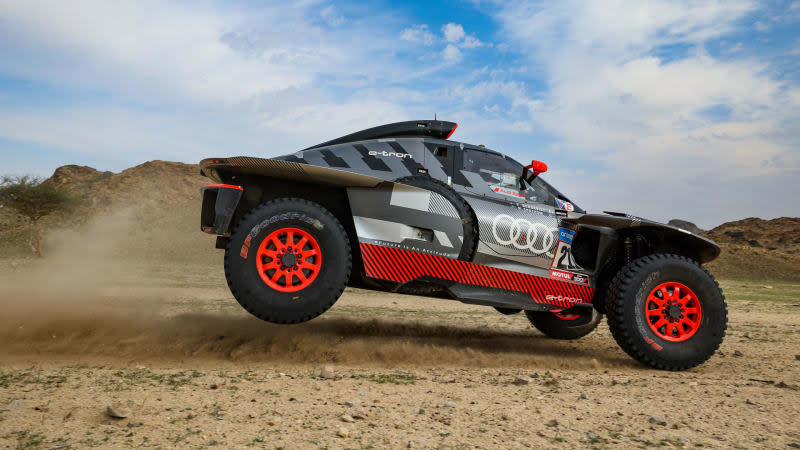Dunes don't care if you're electric: What happened to Audi at Dakar?

DAMMAM, Saudi Arabia – The desert does not forgive. She is not nice and she doesn’t care that you’ve spent millions of dollars and countless hours to prepare for a rally, even if you are Audi and even if the rally is the world-famous Dakar.
The Dakar Rally stretches over 14 stages through Saudi Arabia. Each day’s stages are kept secret until 15 minutes before go time. Navigators are given a digital roadbook and must guide their drivers through rock-strewn fields, over giant dunes and across flooded rivers. Neither GPS nor outside assistance are allowed. It’s a brutal challenge that is both thrilling and exhausting, pushing both human and machine to the absolute limit. Only the strong survive, and sometimes even those folks fail.
Audi had a tough go this year with the re-vamped RS Q E-Tron E2 hybrid race car. This is the second year the company has campaigned three vehicles, but after 14 days of racing, only one finished … in 14th place. They arrived nearly seven hours after winners Nassar Al-Atttiyah and Mathieu Baumel in their Toyota Hilux.
The E2 is propelled by electricity stored in its 52-kilowatt-hour battery, but it features an onboard generator in the form of the 2.0-liter turbocharged four-cylinder engine that Audi has campaigned in DTM, one of the best-known international touring car race series. This combustion engine can charge the battery on the go, ensuring that the E2 has enough juice for the stage.

A typical Dakar Rally stage can be anywhere from 400 to 800 or more kilometers long. That kind of range just isn’t possible with current battery technology, hence the DTM engine. However, the E2 only takes a maximum of 340 liters of fuel per stage, while other vehicles swallow up to 500 liters.
Audi is also using a special blend of ethanol-to-gasoline and e-methanol to drive that combustible engine. This mixture is made of 80% sustainable contents, resulting in 60% fewer carbon emissions than a traditional gasoline. The company hopes to run with 100% renewable fuel in the near future. Hey, if you can’t run on pure electric, might as well make the fuel less harmful to the environment.
Audi brought back the same three driver/navigator teams for this year’s Dakar (Stéphane Peterhansel/Edouard Boulanger in car 204, Carlos Sainz/Lucas Cruz in car 207 and Mattias Ekström/Emil Bergkvist in car 211), but the vehicles got a pretty good overhaul.
The redesigned body allows for a lower center of gravity and better aerodynamics. Although the top speed remains unchanged at 170 km/h per the rally regulations, the reduction in overall drag means the car is more efficient. The car also shed 80 kilograms for a slightly better power-to-weight ratio. The cabin has remained the same, although a few tweaks were made for driver ergonomics. The spare tires are easier to access and the new 10-spoke wheels make them easier to handle during tire changes. Put a pin in that last one, folks, as it will come back around in a bit.
In its first Dakar last year, Audi did really well, taking 14 individual stage podiums among its three cars, and one of the cars ended up in the top 10. This year the story wasn’t quite so bright.

Bad luck from the green flag
During four consecutive legs at the start of the rally, the three Audi cars suffered a total of 14 punctures. Good thing they had those new easy-to-handle wheels, right?
All tires in the class are provided by BFGoodrich, and frankly, this kind of failure is quite the surprise. The route was full of rocks, but 14 flats among three cars is a massive setback. Other teams were plagued by flats during the same sections, so it must have been incredibly rocky terrain. BFG says it will analyze the data to identify any possible failure points in the all-terrain tires. Let’s hope the company can use this knowledge to improve its next generation of off-road race tires.
More problems occurred on stage 6. Peterhansel crashed out and navigator Boulanger was taken to hospital with back pain. Fortunately, he is expected to make a full recovery, but the car had to be retired for the remainder of the rally.
The bad luck continued when Sainz and Cruz crashed in the same spot a few minutes later, tearing off their left front wheel. Drivers have no radio communication with their teammates or crew chiefs, and can only use their satellite phones when stopped. There was no way for Peterhansel to warn Sainz of the dangerous dune. Imagine Peterhansel’s surprise seeing Sainz jump the dune in the same spot, knowing the Spaniard’s fate before he did.


A word about crashing in the dunes here. If drivers are just cruising the dunes and not in competition, the mantra is “only drive what you can see.” When cresting a dune you approach it from the side, peek over and proceed if it is safe.
In the Dakar, it’s tough to come up sideways and take a peek at the other side. Teams have to stay on their heading if they want to keep on the correct route. Turn sideways and the next thing you know you’re 10 degrees off your heading, going in the wrong direction.

 Yahoo Autos
Yahoo Autos 
